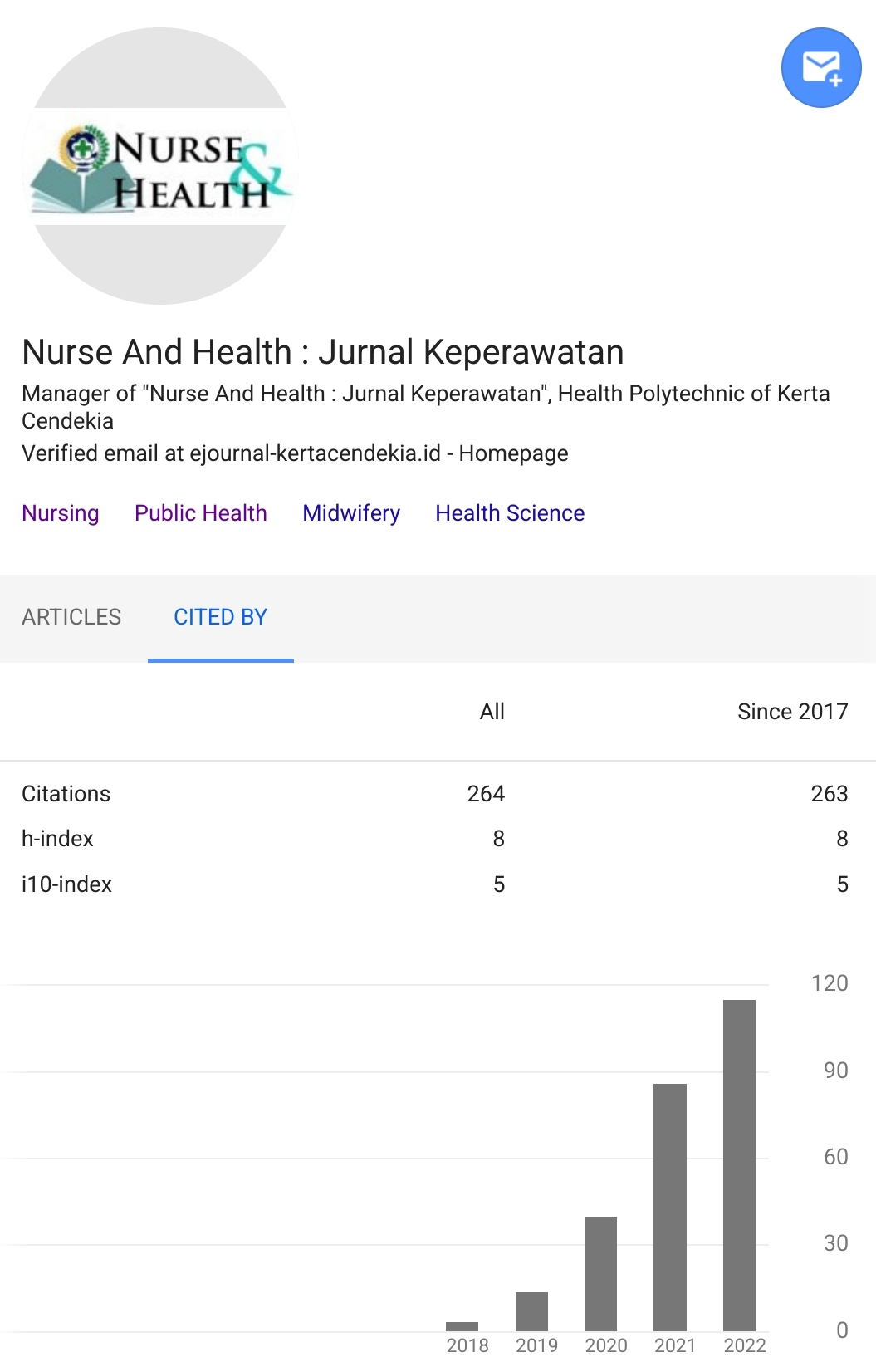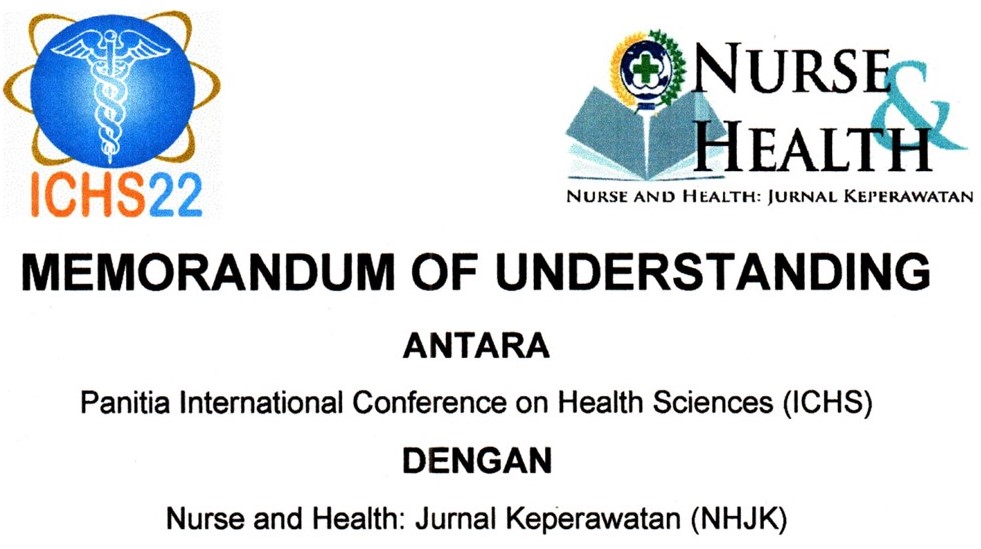EFFECT OF KANGAROO MOTHER CARE (KMC) ON THE FORMATION OF MATERNAL-INFANT ATTACHMENT BETWEEN MOTHERS AND PREMATURE BABIES: A LITERATURE REVIEW
Abstract
Background: Nursing care of premature babies in the Neonatal Intensive Care Unit (NICU) setting can inhibit the maternal-infant attachment. One of the evidence-based interventions for premature babies is Kangaroo Mother Care (KMC). KMC needs to be further studied and researched through a review of previous articles to ensure the effectiveness of that implementation. However, there is a very limited review that specifies the effect of KMC on the formation of maternal-infant attachment. Objective: This study was conducted to assess the effect of KMC on maternal-infant attachment between mothers and premature babies. Design: The design of this study uses a literature review. Data Sources: Initial searches of journal articles were performed on the Pubmed, ScienceDirect, and CINAHL search databases. The study found 676 articles but only 7 journal articles that met the search inclusion criteria. Review Methods: A literature review procedures were used to collect library data, reading and taking notes, as well as critical assessment of managing research materials. Results: The results of this review showed that KMC has been shown to have a positive impact on improving attachment status and resulting in a lower risk of bonding failure between mothers and premature babies. Conclusion: It is recommended that health workers can provide treatment using KMC as an intervention to improve the formation of maternal-infant attachment between mothers and premature babies. The policies related to the implementation of KMC as standard operating procedures are also important.Downloads
References
Ahn, Y., Lee, J., & Shin, H. (2010). Kangaroo care on premature infant growth and maternal attachment and post-partum depression in South Korea. Journal of Tropical Pediatrics, 56(5), 342–344. https://doi.org/10.1093/tropej/fmq063 DOI: https://doi.org/10.1093/tropej/fmq063
Arya, S., Naburi, H., Kawaza, K., Newton, S., Anyabolu, C., Bergman, N., Rao, S., Mittal, P., Assenga, E., Gadama, L., & Larsen-Reindorf, R. (2021). Immediate “Kangaroo Mother Care” and survival of infants with low birth weight. The New England Journal of Medicine, 384, 2028–2038. https://doi.org/10.1056/NEJMoa2026486 DOI: https://doi.org/10.1056/NEJMoa2026486
Bera, A., Ghosh, J., Singh, A. K., Hazra, A., Som, T., & Munian, D. (2014). Effect of kangaroo mother care on vital physiological parameters of the low birth weight newborn. Indian Journal of Community Medicine, 39(4), 245–249. https://doi.org/10.4103/0970-0218.143030 DOI: https://doi.org/10.4103/0970-0218.143030
Çelik, M. Y., & Çiğdem, Z. (2022). Effect of kangaroo care on Vulnerable Infant Syndrome in mother. Early Child Development and Care, 192(3), 499–511. https://doi.org/10.1080/03004430.2021.1932859 DOI: https://doi.org/10.1080/03004430.2021.1932859
Chan, G. J., Valsangkar, B., Kajeepeta, S., Boundy, E. O., & Wall, S. (2016). What is kangaroo mother care? Systematic review of the literature. Journal of Global Health, 6(1), 1–9. https://doi.org/10.7189/jogh.06.010701 DOI: https://doi.org/10.7189/jogh.06.010701
Charpak, N., Ruiz-Peláez, J. G., De Figueroa, Z., & Charpak, Y. (2001). A randomized, controlled trial of Kangaroo Mother Care: Results of follow-up at 1 year of corrected age. Pediatrics, 108(5), 1072–1079. https://doi.org/10.1542/peds.108.5.1072 DOI: https://doi.org/10.1542/peds.108.5.1072
Cho, E. S., Kim, S. J., Kwon, M. S., Cho, H., Kim, E. H., Jun, E. M., & Lee, S. (2016a). The effects of kangaroo care in the Neonatal Intensive Care Unit on the physiological functions of preterm infants, maternal-infant attachment, and maternal stress. Journal of Pediatric Nursing, 31(4), 430–438. https://doi.org/10.1016/j.pedn.2016.02.007
Cho, E. S., Kim, S. J., Kwon, M. S., Cho, H., Kim, E. H., Jun, E. M., & Lee, S. (2016b). The effects of kangaroo care in the Neonatal Intensive Care Unit on the physiological functions of preterm infants, maternal-infant attachment, and maternal stress. Journal of Pediatric Nursing, 31(4), 430–438. https://doi.org/10.1016/j.pedn.2016.02.007 DOI: https://doi.org/10.1016/j.pedn.2016.02.007
de Cock, E. S. A., Henrichs, J., Vreeswijk, C. M. J. M., Maas, A. J. B. M., Rijk, C. H. A. M., & van Bakel, H. J. A. (2016). Continuous feelings of love? The parental bond from pregnancy to toddlerhood. Journal of Family Psychology, 30(1), 125–134. https://doi.org/10.1037/fam0000138 DOI: https://doi.org/10.1037/fam0000138
Dodwell, M. (2010). The effects of postnatal separation on mother-infant interaction (Issue January).
Føreland, A. M., Engesland, H., Kristoffersen, L., & Fegran, L. (2022). Postpartum experiences of early skin-to-skin contact and the traditional separation approach after a very preterm birth: a qualitative study among mothers. Global Qualitative Nursing Research, 9, 1–9. https://doi.org/10.1177/23333936221097116 DOI: https://doi.org/10.1177/23333936221097116
Frazier, K. F., & Scharf, R. J. (2015). Parent-infant attachment. Pediatrics in Review, 36(1), 5–8. DOI: https://doi.org/10.1542/pir.36-1-41
Fuchs, A., Möhler, E., Reck, C., Resch, F., & Kaess, M. (2016). The early mother-to-child bond and its unique prospective contribution to child behavior evaluated by mothers and teachers. Psychopathology, 49(4), 211–216. https://doi.org/10.1159/000445439 DOI: https://doi.org/10.1159/000445439
Galbally, M., Lewis, A. J., Ijzendoorn, M. Van, & Permezel, M. (2011). The role of oxytocin in mother-infant relations: A systematic review of human studies. Harvard Review of Psychiatry, 19(1), 1–14. https://doi.org/10.3109/10673229.2011.549771 DOI: https://doi.org/10.3109/10673229.2011.549771
Guillaume, S., Michelin, N., Amrani, E., Benier, B., Durrmeyer, X., Lescure, S., Bony, C., Danan, C., Baud, O., & Jarreau, P. (2013). Parents’ expectations of staff in the early bonding process with their premature babies in the intensive care setting : a qualitative multicenter study with 60 parents. BMC Pediatrics, 13(1), 1. https://doi.org/10.1186/1471-2431-13-18 DOI: https://doi.org/10.1186/1471-2431-13-18
Güleç, D., & Kavlak, O. (2013). The study of reliability and validity of paternal-infant attachment scale in Turkish society. Journal of Human Sciences, 10(2), 170–181.
Karakaş, N. M., & Dağlı, F. Ş. (2019). The importance of attachment in infant and influencing factors. Turk Pediatri Arsivi, 54(2), 76–81. https://doi.org/10.14744/TurkPediatriArs.2018.80269
Kurt, F., Kucukoglu, S., Ozdemir, A., & Ozcan, Z. (2020). The effect of kangaroo care on maternal attachment in preterm infants. Nigerian Journal of Clinical Practice, 23, 26–32. https://doi.org/10.4103/njcp.njcp DOI: https://doi.org/10.4103/njcp.njcp_143_18
Maastrup, R., Weis, J., Engsig, A. B., Johannsen, K. L., & Zoffmann, V. (2018). ‘Now she has become my daughter’: parents’ early experiences of skin-to-skin contact with extremely preterm infants. Scandinavian Journal of Caring Sciences, 32(2), 545–553. https://doi.org/10.1111/scs.12478 DOI: https://doi.org/10.1111/scs.12478
Mason, Z. S., Briggs, R. D., & Silver, E. J. (2011). Maternal attachment feelings mediate between maternal reports of depression, infant social-emotional development, and parenting stress. Journal of Reproductive and Infant Psychology, 29(4), 382–394. https://doi.org/10.1080/02646838.2011.629994 DOI: https://doi.org/10.1080/02646838.2011.629994
Mehler, K., Hucklenbruch-Rother, E., Trautmann-Villalba, P., Becker, I., Roth, B., & Kribs, A. (2020). Delivery room skin-to-skin contact for preterm infants—A randomized clinical trial. Acta Paediatrica, International Journal of Paediatrics, 109(3), 518–526. https://doi.org/10.1111/apa.14975 DOI: https://doi.org/10.1111/apa.14975
Mehler, K., Wendrich, D., Kissgen, R., Roth, B., Oberthuer, A., Pillekamp, F., & Kribs, A. (2011). Mothers seeing their VLBW infants within 3 h after birth are more likely to establish a secure attachment behavior: Evidence of a sensitive period with preterm infants. Journal of Perinatology, 31(6), 404–410. https://doi.org/10.1038/jp.2010.139 DOI: https://doi.org/10.1038/jp.2010.139
Mehrpisheh, S., Doorandish, Z., Farhadi, R., Ahmadi, M., Moafi, M., & Elyasi, F. (2022). The effectiveness of Kangaroo Mother Care (KMC) on attachment of mothers with premature infants. European Journal of Obstetrics and Gynecology and Reproductive Biology: X, 15(April), 1–4. https://doi.org/10.1016/j.eurox.2022.100149 DOI: https://doi.org/10.1016/j.eurox.2022.100149
Meijssen, D., Wolf, M.-J., Bakel, H. Van, Koldewijn, K., Kok, J., & Baar, A. Van. (2011). Maternal attachment representations after very preterm birth and the effect of early intervention. Infant Behavior and Development, 34(1), 72–80. https://doi.org/10.1016/j.infbeh.2010.09.009 DOI: https://doi.org/10.1016/j.infbeh.2010.09.009
Miller, P. M., & Commons, M. L. (2010). The benefits of attachment parenting for infants and children: a behavioral developmental view. Behavioral Development Bulletin, 16(1), 1–14. https://doi.org/10.1037/h0100514 DOI: https://doi.org/10.1037/h0100514
Sahlén Helmer, C., Birberg Thornberg, U., Frostell, A., Örtenstrand, A., & Mörelius, E. (2020). A randomized trial of continuous versus intermittent skin-to-skin contact after premature birth and the effects on mother-infant interaction. Advances in Neonatal Care : Official Journal of the National Association of Neonatal Nurses, 20(3), 1–9. https://doi.org/10.1097/ANC.0000000000000675 DOI: https://doi.org/10.1097/ANC.0000000000000675
Samra, N. M., Taweel, A. El, & Cadwell, K. (2013). Effect of intermittent Kangaroo Mother Care on weight gain of low birth weight neonates with delayed weight gain. The Journal of Perinatal Education, 22(4), 194–200. https://doi.org/10.1891/1058-1243.22.4.194 DOI: https://doi.org/10.1891/1058-1243.22.4.194
Twohig, A., Reulbach, U., Figuerdo, R., McCarthy, A., McNicholas, F., & Molloy, E. J. (2016). Supporting preterm infant attachment and socioemotional development in the Neonatal Intensive Care Unit: staff perceptions. Infant Mental Health Journal, 37(2), 160–171. https://doi.org/10.1002/imhj.21556 DOI: https://doi.org/10.1002/imhj.21556
Vahdati, M., Mohammadizadeh, M., & Talakoub, S. (2017). Effect of kangaroo care combined with music on the mother-premature neonate attachment: a randomized controlled trial. Iranian Journal of Nursing and Midwifery Research, 22(5), 403–407. https://doi.org/10.4103/ijnmr.IJNMR_50_16 DOI: https://doi.org/10.4103/ijnmr.IJNMR_50_16
Vogel, J. P., Chawanpaiboon, S., Moller, A. B., Watananirun, K., Bonet, M., & Lumbiganon, P. (2018). The global epidemiology of preterm birth. Best Practice and Research: Clinical Obstetrics and Gynaecology, 52, 3–12. https://doi.org/10.1016/j.bpobgyn.2018.04.003 DOI: https://doi.org/10.1016/j.bpobgyn.2018.04.003
WHO. (2003). Kangaroo mother care: a practical guide. In WHO: Department of Reproductive Health and Research.
Yalçin, S. S., Örün, E., Mutlu, B., Madendaǧ, Y., Sinici, I., Dursun, A., Özkara, H. A., Üstünyurt, Z., Kutluk, Ş., & Yurdakök, K. (2010). Why are they having infant colic? A nested case-control study. Paediatric and Perinatal Epidemiology, 24(6), 584–596. https://doi.org/10.1111/j.1365-3016.2010.01150.x DOI: https://doi.org/10.1111/j.1365-3016.2010.01150.x
Zhang, B., Yue, J., Duan, Z., Zhao, Y., Williams, S., Huang, L., Zhang, X., Wu, W., Zhang, L., Liu, J., & Zhao, G. (2021). Maternal experience of intermittent kangaroo mother care for late preterm infants: a mixed-methods study in four postnatal wards in China. BMJ Open, 11(9), 1–8. https://doi.org/10.1136/bmjopen-2021-050221 DOI: https://doi.org/10.1136/bmjopen-2021-050221
Copyright (c) 2024 Zubaidah Zubaidah, Ayu Diah Safitri

This work is licensed under a Creative Commons Attribution-NonCommercial 4.0 International License.
Authors who publish with Nurse and Health: Jurnal Keperawatan agree to the following terms:
- Authors retain copyright licensed under a Creative Commons Attribution-NonCommercial 4.0 (CC BY-NC 4.0), which allows others to remix, tweak, and build upon the authors' work non-commercially, and although the others' new works must also acknowledge the authors and be non-commercial, they don't have to license their derivative works on the same terms.
- Authors are permitted and encouraged to post their work online (e.g., in institutional repositories or on their website) prior to and during the submission process, as it can lead to productive exchanges, as well as earlier and greater citation of published work (See The Effect of Open Access). Authors can archive pre-print and post-print or publisher's version/PDF.







_resize1.jpg)















